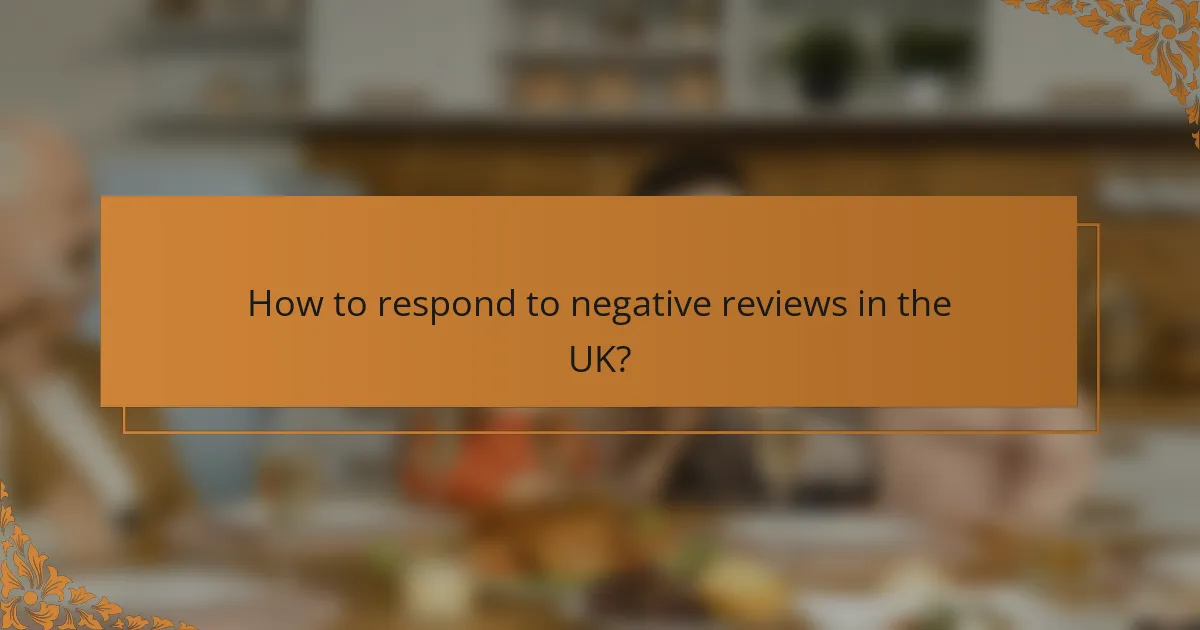Online reputation management (ORM) is essential for businesses looking to maintain a positive image in the digital landscape. By effectively responding to reviews, particularly negative ones, companies can address customer concerns and demonstrate their commitment to satisfaction. While ORM offers benefits such as increased trust and brand visibility, it also comes with challenges, including the time and resources needed to manage feedback effectively.

How to respond to negative reviews in the UK?
To effectively respond to negative reviews in the UK, acknowledge the customer’s concerns and provide a solution or explanation. This approach not only addresses the issue but also demonstrates your commitment to customer satisfaction.
Template for professional responses
When crafting a professional response, maintain a respectful and formal tone. Start by thanking the reviewer for their feedback, then briefly address their concerns without becoming defensive. For example:
Response Template:
“Dear [Reviewer’s Name], thank you for your feedback. We are sorry to hear about your experience and appreciate you bringing this to our attention. We strive to provide the best service and would like to resolve this issue. Please contact us at [contact information].”
Template for empathetic responses
Empathetic responses should convey understanding and compassion. Acknowledge the emotional impact of the review and express genuine concern. For instance:
Response Template:
“Hi [Reviewer’s Name], we’re truly sorry to hear that you felt this way. Your feelings are valid, and we appreciate you sharing your experience. We would love to make this right for you. Please reach out to us at [contact information].”
Template for addressing specific complaints
When addressing specific complaints, it’s crucial to directly tackle the issue raised. Provide details on how you plan to rectify the situation. For example:
Response Template:
“Hello [Reviewer’s Name], thank you for your feedback regarding [specific issue]. We understand how frustrating this can be and are currently reviewing our processes to ensure this does not happen again. Please contact us at [contact information] so we can assist you further.”

What are the benefits of online reputation management?
Online reputation management (ORM) offers several advantages, including the ability to build trust with customers, enhance brand visibility, and foster greater customer engagement. By actively managing online reviews and feedback, businesses can create a positive image that resonates with their target audience.
Improved customer trust
One of the primary benefits of online reputation management is improved customer trust. When businesses respond to reviews and address customer concerns, it demonstrates a commitment to customer satisfaction. This transparency can lead to higher levels of trust among potential customers.
To foster trust, businesses should consistently monitor their online presence and engage with customers. A timely response to negative feedback can turn a dissatisfied customer into a loyal advocate. Aim to respond to reviews within a few days to show that you value customer input.
Increased brand visibility
Online reputation management can significantly increase brand visibility. Positive reviews and high ratings can improve search engine rankings, making it easier for potential customers to find your business. This visibility can lead to more website traffic and higher conversion rates.
To enhance visibility, encourage satisfied customers to leave positive reviews on platforms like Google, Yelp, or industry-specific sites. Consider implementing a review generation strategy that includes follow-up emails or incentives for leaving feedback.
Enhanced customer engagement
Effective online reputation management enhances customer engagement by creating opportunities for interaction. Engaging with customers through responses to reviews or social media comments can build a community around your brand. This interaction fosters loyalty and encourages repeat business.
To improve engagement, actively solicit feedback and create content that resonates with your audience. Regularly update your online profiles and respond to inquiries promptly. This approach not only strengthens relationships but also encourages customers to share their positive experiences with others.

What are the drawbacks of online reputation management?
Online reputation management (ORM) can have several drawbacks that businesses should consider. These include the time and effort required, the risk of negative feedback, and the costs associated with various management tools.
Time-consuming processes
Managing an online reputation often involves extensive monitoring and responding to reviews across multiple platforms. This can be a time-consuming process, requiring dedicated resources to ensure timely and effective responses.
Businesses may need to allocate staff or hire external agencies to handle the workload, which can strain smaller organizations. Regularly updating content and engaging with customers online is essential but can take considerable time to manage effectively.
Potential for negative backlash
Efforts to manage an online reputation can sometimes backfire, leading to negative backlash from customers. If responses to reviews are perceived as insincere or overly promotional, it may aggravate the situation rather than improve it.
Additionally, if a company focuses too much on addressing negative feedback without acknowledging positive comments, customers may feel undervalued. Striking a balance is crucial to avoid alienating your audience.
Costs associated with management tools
Implementing effective online reputation management often requires investment in various tools and services. These can range from basic monitoring software to comprehensive reputation management platforms, with costs varying widely.
Businesses should expect to spend anywhere from a few hundred to several thousand dollars per month, depending on the features and level of service required. It’s essential to evaluate the return on investment to ensure that the benefits justify the expenses incurred.

What tools can assist with online reputation management?
Several tools can effectively assist with online reputation management by monitoring mentions, analyzing reviews, and managing social media interactions. Utilizing these tools can help businesses maintain a positive online presence and respond promptly to customer feedback.
Google Alerts for monitoring
Google Alerts is a free tool that allows users to monitor the web for specific keywords or phrases related to their brand. By setting up alerts, businesses receive notifications whenever their name or relevant terms are mentioned online, enabling them to stay informed about their reputation.
To make the most of Google Alerts, choose specific keywords and set the frequency of notifications to daily or weekly. This way, you can quickly address any negative mentions or capitalize on positive feedback. Regularly review and adjust your alerts to capture new terms as your brand evolves.
ReviewTrackers for analysis
ReviewTrackers is a comprehensive platform designed to gather and analyze customer reviews from various sites, providing valuable insights into customer sentiment. This tool aggregates reviews from multiple sources, allowing businesses to track their overall reputation and identify trends over time.
When using ReviewTrackers, focus on key metrics such as average ratings and review volume. This data can help you understand customer perceptions and guide your response strategies. Additionally, consider utilizing the platform’s reporting features to share insights with your team and inform decision-making.
Hootsuite for social media management
Hootsuite is a popular social media management tool that enables businesses to schedule posts, monitor engagement, and respond to customer inquiries across multiple platforms. This tool is essential for managing your brand’s online reputation through active social media presence.
To effectively use Hootsuite, create a content calendar to plan your posts in advance and ensure consistent engagement. Monitor mentions of your brand in real-time to respond promptly to comments or concerns. Regularly analyze your social media performance metrics to refine your strategy and improve your online reputation.

How to create effective review response templates?
Creating effective review response templates involves crafting standardized replies that can be tailored to various customer feedback scenarios. These templates should be clear, professional, and reflect your brand’s voice while addressing specific customer concerns.
Key elements to include
Effective review response templates should include a greeting, acknowledgment of the customer’s feedback, a personalized comment addressing their specific points, and a closing statement inviting further communication. Including a thank you for their feedback can enhance the positive tone.
Additionally, consider incorporating a call to action, such as encouraging the customer to reach out directly for further assistance. This shows that you value their input and are committed to resolving any issues.
Customizing templates for different scenarios
Customization is crucial for making templates feel personal and relevant. For positive reviews, express gratitude and highlight how their feedback reinforces your commitment to quality. For negative reviews, acknowledge the issue, apologize sincerely, and offer a solution or a way to rectify the situation.
When responding to neutral reviews, focus on inviting further dialogue and encouraging the customer to share more about their experience. Tailoring your response based on the sentiment of the review helps build trust and rapport with your audience.
Examples of successful templates
For a positive review, a template could read: “Thank you, [Customer Name], for your kind words! We’re thrilled to hear you enjoyed [specific product/service]. Your feedback inspires us to keep delivering great experiences!”
In contrast, a negative review response might say: “Hi [Customer Name], we’re sorry to hear about your experience with [specific issue]. We appreciate your feedback and would love to resolve this. Please contact us at [contact information] so we can assist you.” This approach demonstrates accountability and a willingness to improve.
